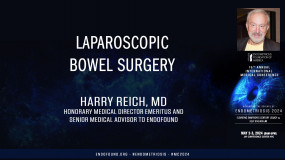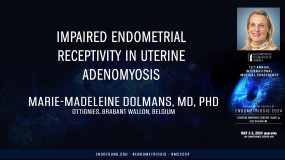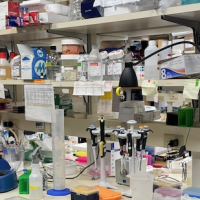International Medical Conference
Endometriosis 2024:
Elevating Sampson’s Century Legacy via
Deep Dive with AI
For the benefit of Endometriosis Foundation of America (EndoFound)
May 2-3, 2024 - JAY CENTER (Paris Room) - NYC
I will share with you a quite difficult question and we will try to answer deep endometriosis and uterine Aden myosis to different phenotype of the same disease. And I will share with you this paper published last month in best practice on research clinical obstetric and gynecology about the similarities and differences between endometrial and aosis. That is the program of my lecture. I will start with historical data and it's a little bit back to the future. In fact, the first description of lesions was of named adenoma, was provided by Carl von Ky and that was considered like a cystos sarcoma. And only several years later, in 19 25, 2 years before Samsung coined the term and Rios Frank created a name form mucosal invasion of the myometrium called Dens ery. It was the first time that this term was used to explain the invasion of the mucosa in the myometrium.
But really surprisingly, several years later, Samson defined the sac obliteration as extensive addition in the sac obliterating lower portion and uniting the cervix of the lower portion of the uterus to the rectum. And he called the term at the normal of the endometrial type and only several years later that the term deep and demetris was used. But finally, if you think of the literature, you see that Ky Frankel and Sam already suggests the association between adenomyosis and endometriosis. Several years later, we published this paper which has been seated very frequently, and for the first time we call back the Aden Miotic nodule of rectovaginal septum considering separate entities from peritoneal endometriosis and ovarian endometriosis. This term was used also when bladder endometriosis was considered. And we consider in the title that we should call this bladder and ome as bladder adenomyosis. And you can see clearly that the under wall of the uterus is also invaded by this tissue. And when you removed it, it just been removed by laparoscopy. We have this type of pathological finding and that was published in 2000. In fact, you showed this slide to a pathologist, he will answer to you at the osis that is exactly like at theosis of the uterus. That is for the story historical data.
What about the magnetic resonance? Emerging analysis, coexistence of both disease. There was a nice cartoon published by from the John Hopkins Hospital when on the skeleton, clearly different type of, and Rios and neu are on the same picture. And in fact, this happened much more frequently than expected. And there are three paper by Charles Chapon, our group and Bazo, we clearly make the association between endometriosis and adenoma is considered. That is very frequent. In fact, in the description by all the lesions, by Basel clearly in a part of the cartoon, the association between adenomyosis and endometrial with attraction to the rectum or to the bladder were clearly defined. And remember that Bazo is not a gynecologist, he's a radiologist. And in the two paper following that by shell chaperone and by our group, we have analyzed the relationship between adenomyosis and endometriosis. Clearly in our department, we have analyzed retrospectively the association between deep endometrial with external utero, cervical adenomas, and junctional zone anomalies. This is a retrospective study. We select only the case with deep nodule. More than three centimeters is a huge selection of the case. And in fact, the association between what we call external utero, cervical adenomyosis, like in that case, exists in nearly one other person of case and isolated association with junctional zone anomalies in nearly 30% at that time. By this different publication, the association between deep endometriosis and adenomyosis could be advocated.
If we agree with that concept. Can we explain the mechanism? Are we able to identify common pathogenic features in both disease? It's what we have done and published. And that journal of clinical medicine, identifying common pathogenic feature in deep endometrioid nodule and ute adenomyosis and I will show you the result. In fact, we analyze the role of inflammatory cells and fibrosis in deep endometriosis and adenomyosis. And clearly we select several cases. We took biopsy from the endometrium from healthy women utopic and endometrium from women with deep endometriosis from the nodule, what we call ectopic from deep endometriosis nodule atopic endometrium from Aden women and the ectopic lesions from Aden miotic women, which mean biopsy deep into the myometrium, revealing the endometrial glands. First analysis was the immuno thinning by the CD 41, which revealed the platelets activity. And obviously the platelets activity is reduced in ect, in den and in ectopic, in denio women when compared to the corresponding endometrium and corresponding also and when compared to the healthy endometrium. When we analyze the macrophage activity, there is a significant increase of the macrophage activity in tissue from then an ectopic tissue, ectopic ectopic tissue, sorry, from the miotic women.
When we analyze the fibrosis, the fibrosis is obvious here on that picture that the fibrosis is significantly increased in ectopic endometrium as well in the deep endometrial lesions as well and other miotic. And we go further to analyze the vascularization. And by analyzing the vascularization, we were unable to demonstrate any difference from the VAGF. But in fact when we analyze, we see some difference in the macrovascular density and also in the maturity of the vessels. So that the macrophage activity was for us a concern that we'll like to analyze deeper. And there was a study made in the lab of press by clu. We evaluate the role of M two macrophage on the culture promoting the endometrial cells in uterine adenomyosis. In fact, if you can see here the epithelial invasion capacity as well as the stromal invasion capacity, you see that when we put the cell epithelial cells in culture in the presence of M two macrophage, there was an increase of the invasion capacity in the adeno myotic women more significant that in the women from the control group, that was the same result from the stromal capacity. It means that the M two macrophage macrophage activated microphage play a role in the invasion process.
And it was will be published very soon. It's accepted. And in press of course, we have to analyze the role of oxidative stress. We have forget for a long time the role of iron which produce oxidative stress and other on the other side, the RoCE cyte can stimulate the macrophage, activate the macrophage, which are for the peritoneal cavity, responsible for the cleaning of the peritoneal cavity. But when they are activate or overwhelmed, they play a role in the oxidative stress and in the invasion of the tissue.
This cattle will be also published very soon. And it explained the role of the macrophage that are able to phagocyte, of course heme and to be the cargo of the hemo cine. But don't forget that they're also responsible to initiate oxidative stress by the significant increase of the reactive oxygen spaces. And when the macrophage are activated, they are able to promote the invasion, the additions, the androgenesis, and the activation of the inflammation. Just imagine that in the future we may influence the macrophage activity by depleting the macrophage activity. We have maybe an options to influence the development of the disease. And we are not alone to have this idea. A lot of people have this idea, and I would like to go with you with this excellent paper and review published by the team of Christian Baker in a human reproduction very, very soon. And you see that you focus on the small extracellular vesicular, which are the cargo for the micro RNA. What's happens, in fact, the red blood cells or the cells are able, and the endometrial cells too are able to release the small extra physical, physical which contain the macro Renee, but they are able also to activate the macrophage, which afterwards are able to release themself several extra physical, extracellular physical with a macro, a influencing the opposition, the transformation, and the angiogenesis to finally provoke the endometriosis lesions.
Apoptose autophagy and progesterone resistance also implicated in both disease. Asay by Mary Madeline in progesterone resistance has been proved with endo myosis and has proved in endometriosis autophagy and apoptose in both disease should be evaluated. And finally, the experimental model. There are three paper which has been extensively discussed with three deep conning is the thesis of Olivier and the BA model. In fact, when we have a transplant in the baboon and theum junctional zone and myometrium, we think to reproduce the deep and Demetri lesions, but in fact we have reproduced deep uterine adenomyosis like its proof. In next picture here you see very well the big nodule here with some invasion of the glance through the boel wall. So that in fact some experimental model reproduce very well, the adenomyosis, which is quite similar to deep end omes, but suggests at that time for the baboon model and hypothesis so that in fact we have to come back to several idea. This paper was published by the lab. And of course, in case of Uteran Aosis, a majority of the authors are in favor of what we call TIAR. The endometrial invasion responsible for adenomyosis. Or the second hypotheses is the presence of Ian remnant into the myometrium. But from the recent publication of the lab, we have to pay more attention to the sensors which are present in the endometrium and in the junctional zone. And these stem cells present into the myometrium could be responsible of the adenomyosis process and be responsible by retrograde menstruation of the presence of stem cells able to create and endometrial so that finally the same origin, the stem cells could be at the same origin of the two phenotype.
So that there are difference in similarities. And I had two slide about the treatment management, medical management, and in fact, when you analyze the possibility of medical management for adenomyosis and endometriosis, they are the same. We have to target estrogens, target inflammation, and have CAPA cytokine, Ross Apoptose and autophagy, MT regulators and targeting angiogenesis. But all this pathway are under clinical experimental evaluation. And in fact, there are so many pathway explaining uterine adenomyosis and a deep endometriosis that it remain a long way to find a solution. Finally, are there two different final type of the same disease? I guess yes, but further evidence is needed and maybe the artificial intelligence will give you the answer very, very soon. Thank you for your attention.










